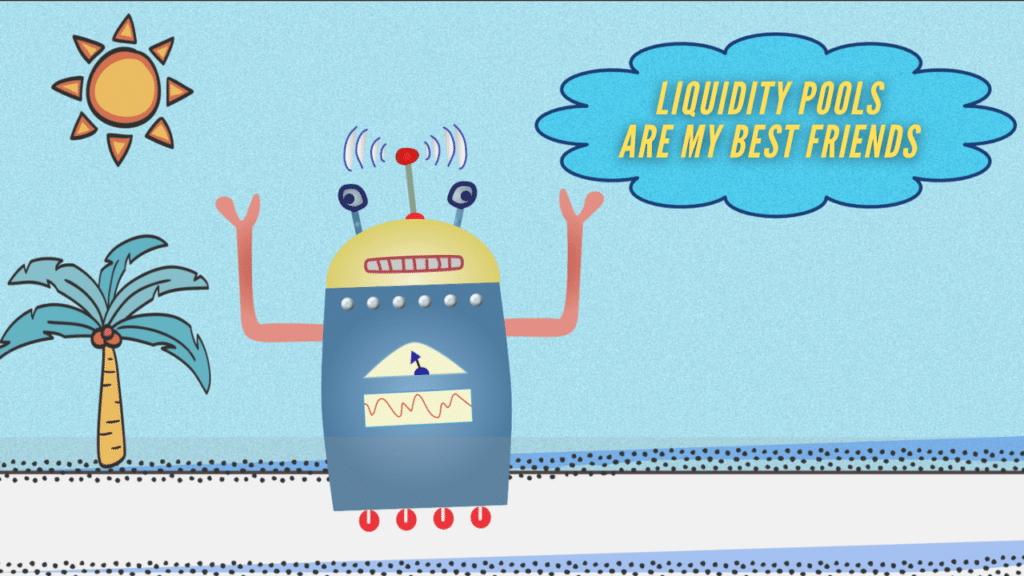Are you afraid of the term liquidity pool? Don’t you really understand what it is all about? Or does it just sound scary and complicated to you? Forget about all of that, because in this article I will explain why a liquidity pool can be your best friend!
I believe this simple and easily explained article will give many people information and help they have been looking for. If you have further comments or questions, write them in the comment field.

When you no longer have to fear impermanent loss!
So, I told you not be to afraid, and here I am already shooting you with one more strange term – impermanent loss. Well, forget about that as well. I am about to tell you about a time when you do not even have to fear impermanent loss. Let us just into it!
Liquidity pools explained (too) easily!
Imagine a store with orange juice bottles and milk bottles. By default, there are ten bottles of each available (this is the liquidity pool). However, someone enters the store and uses orange juice bottles to buy milk bottles. Suddenly, there are 19 juice bottles available and only one milk bottle. What happens? There is a liquidity problem and that will increase the price of the milk bottle, while the juice price will go down. This example explains easily how a big liquidity pool will increase security and make the trading experience more stable, while a tiny liquidity pool will be easy to influence and “abuse.”
Now comes the fun – when you decide to add funds to a liquidity pool!
Let us use our milk token and juice token example! You decide to add 10 juice tokens and 10 milk tokens to a pool (meaning that these have identical value as you add funds to the pool). Let us pretend you are the only person in the actual pool.
Someone comes to trade and buys 5 juice tokens and pays 5,5 milk tokens to get those 5 juice tokens. There will be some gain for the “exchange” provider, but if you decided to cash out your funds from the liquidity pool, you wouldn’t get 10 juice tokens and 10 milk tokens, because they are not existing. Instead, you would get something like 15 milk tokens and 5 juice tokens (the math here is way more complicated, so this is a very “stupid” example just to give you the point), as that is what would be in the pool at that moment.
Since the value of the juice token might be more worth (since a person bought it), you will actually have lost money due to owning more of the “cheaper” token and less of the more expensive token. You get the point? This is, by the way, what they call impermanent loss!
But, when I said that a liquidity pool can be your very best friend. What did I mean?
I am a big fan of Ethereum and I am a big fan of the StrongBlock project (supporting node owners at the Ethereum blockchain and in the future also on other chains). There is a liquidity pool available for Strong/ETH. In other words, I would like to invest in both, and in the end, I would be happy to own a lot of Ethereum and I would be happy to own a lot of Strong tokens.

Now, this is my mentality, and why this is a win-win situation!
I have 2 Ethereum that I want to invest in StrongBlock. But, I would love to own more StrongBlock, and at the same time, I would love to own more Ethereum. So, I buy 20 Strong (1 Ethereum value) and keep 1 Ethereum. I add this combination to the Strong/Ethereum liquidity pool.
And now the fun begins! By default, I have 20 Strong and 1 Ethereum in the pool. But, if Ethereum goes on a moon ride and I decide to cash out, I will remain with maybe 30 Strong tokens and 0,4 Ethereum, which actually will make me happy as well. But, if Strong decides to moon, then I might remain with 10 Strong tokens and 1,5 Ethereum token. And that is the cool thing – I will be happy no matter which direction it takes, because I believe in both projects and would love to own more of all the tokens. And at the same time, I will also receive a percentage of the commission from the liquidity pool, which also comes as a nice bonus.
Do you get the point? This is only true and valid if you put funds into a liquidity pool in which you love both sides. If you hate one of the parts and love the other, then you might be at risk being stuck with a shitcoin. So, think twice before you enter and add funds to a liquidity pool!
I hope these simple instructions have helped you 🙂